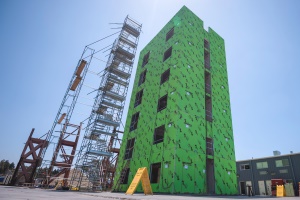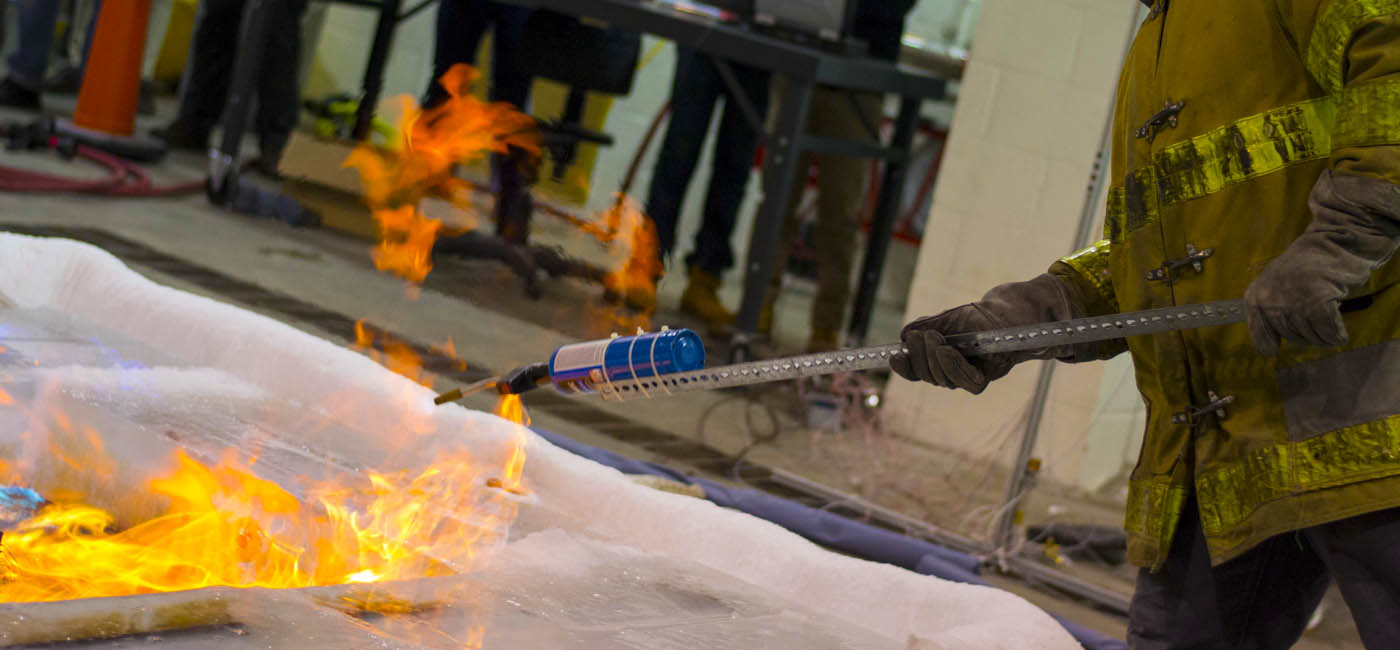 The six-story cold-formed steel building on
The six-story cold-formed steel building on
the world’s largest outdoor shake table at
UC San Diego.
What
A team of researchers from the Department of Fire Protection Engineering at Worcester Polytechnic Institute (WPI) will be conducting burn tests aimed at better understanding the effects of post-earthquake fires on cold-formed steel-framed buildings and assessing various methods for preventing appliances and broken gas mains from igniting fires during quakes.
The tests will be conducted inside a six-story building framed with cold-formed steel (CFS) panels and constructed atop the nation's largest outdoor shake table, located at the University of California San Diego Englekirk Structural Research Laboratories. This will be the first time that a CFS building of this size will undergo fire testing after having endured simulated seismic events.
The use of CFS panels in residential and commercial construction has been increasing due to a number of advantages the panels offer. For example, their high strength-to-weight ratio enables the construction of lighter structures, and the use of the high precision prefabricated panels can greatly reduce construction time. The panels are fire-resistant, which can lower insurance costs. Finally, using the panels produces less construction waste than other building methods, and the panels are recyclable, making CFS construction a more sustainable approach.
In research led by professors Tara Hutchinson and Gil Hegemier of the Center for Extreme Events Research at UC San Diego, the building has already been subjected to a series of simulated earthquakes of increasing magnitude over the course of the past two weeks. More than 250 sensors, 40 video cameras, a GPS system, and unmanned aerial vehicles have recorded data on the movement and structural performance of the building, which has been designed to replicate a multifamily residential structure.
Since post-earthquake fires are a well-known and serious hazard that can put structures, their occupants, and firefighters at risk, the WPI team, led by Brian Meacham, associate professor of fire protection engineering, will use the opportunity to study how earthquake damage might affect the fire performance of a CFS building. During the experiments, the team will gather data that can be used to build new computer models that can assist in the development of more effective fire codes and help architects and engineers design safer buildings.
Meacham and his team will enter the damaged building and conduct fire tests in several rooms and corridors on its second and sixth floors. The researchers will ignite pans of heptane, a liquid fuel that can simulate a fully burning fire within a compartment. The fuel will burn for about 15 minutes—long enough to create temperatures as high as 800 degrees Celsius at the ceiling for 10 minutes. This will simulate flashover conditions, a deadly phenomenon that occurs when a room becomes hot enough for everything in it to burst into flames at once, and generate the post-flashover temperatures that are important for assessing the fire resistance of compartment walls and door systems. Due to environmental and safety concerns, the duration of the fire tests will be much shorter than the duration of actual fires.
Sensors will measure temperatures throughout the compartments where the fires will be set, as well as in adjacent compartments, to assess the damage that the structural system might undergo in an actual post-earthquake fire. Cameras will be located in the fire compartments and adjacent spaces to monitor for indications of smoke and fire spread.
When
Tuesday, June 28, 2016, beginning at 9 a.m. PDT.
Where
Englekirk Structural Research Laboratories, University of California, San Diego, Calif.
More Details on the Testing
With funding to support the fire testing provided by the California Seismic Safety Commission and insurance industry partner the Institute for Business and Home Safety, the earthquake tests included assessment of the potential for home appliances to move about due to shaking, potentially serving as sources of ignition (electrical faults) and fuel (gas connection breaks). In particular, water heaters and stoves were installed on the first and sixth floors, some with bracing and some without. In addition, State Farm installed a smart device designed to detect seismic waves and shut off a building's gas lines before the shaking becomes severe.
"We greatly appreciate funding from the California Seismic Safety Commission, the Society of Fire Protection Engineers, and WPI," Meacham said. "This support, along with the building provided by CEMCO and Sureboard, enabled us to design and undertake the live fire tests. The tests are essential in helping us understand the post-earthquake fire performance of CFS buildings—a technology that has considerable potential for sustainable housing and commercial properties."
More Information
More information about the overall project can be found here. The fire test will be webcast here.


